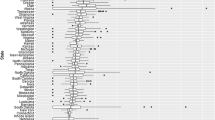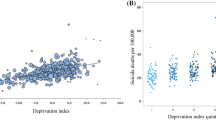Abstract
Few studies in the Southeastern U.S. have examined county-level spatial patterning in suicide clusters, and no studies have examined clustering at the census block group. The objective of this retrospective ecological study is to identify high-risk suicide clusters and characterize the community-level factors associated with suicides inside and outside spatial clusters. We used the discrete Poisson SatScan statistic to identify spatial clusters in suicide for North Carolina, 2000–2017. A suicide cluster was defined as a statistically significant cluster of suicide events. Community-level determinants were obtained from the American Community Survey, and logistic regression models were used to examine the association between community-level determinants and suicide clusters. A total of 12 statistically significant high-risk spatial clusters were identified. Clusters were also identified for specific age-demographics, including adolescents (<25), the working-age population (25 to 64), and the elderly (65>). The risk ratios of suicide varied from 1.27 to 2.05 in high-risk clusters, and spatial clustering was positively associated with being male or residence in a rural area. Multivariable logistic regression found strong associations with income, population change, and educational attainment. Our results highlight the significant geographic heterogeneity in suicide across North Carolina and the need for more research that identifies localized suicide clusters for targeted public health interventions.





Similar content being viewed by others
References
Adjemian, J., Olivier, K. N., Seitz, A. E., Falkinham, J. O., Holland, S. M., & Prevots, D. R. (2012). Spatial clusters of nontuberculous mycobacterial lung disease in the United States. American Journal of Respiratory and Critical Care Medicine., 186(6), 553–558. https://doi.org/10.1164/rccm.201205-0913OC.
Alegría, M., Green, J. G., McLaughlin, K. A., & Loder, S. (2015). Disparities in child and adolescent mental health and mental health services in the US. New York: William T. Grant Foundation.
Atwell, J. E., Van Otterloo, J., Zipprich, J., et al. (2013). Nonmedical vaccine exemptions and pertussis in California, 2010. Pediatrics., 132(4), 624–630.
Balis, T., & Postolache, T. T. (2008). Ethnic differences in adolescent suicide in the United States. International journal of child health and human development: IJCHD, 1(3), 281.
Barkan, S. E., & Rocque, M. (2018). Socioeconomic status and racism as fundamental causes of street criminality. Critical Criminology, 26(2), 211–231.
CDC 2019. Centers for Disease Control and Preventions, 2018. Ten Leading Causes of Death by Age, US. Accessed date: 30 October 2018 —Last updated April 10, 2019 https://www.cdc.gov/injury/wisqars/LeadingCauses.html
Cheung, Y. T. D., Spittal, M. J., Williamson, M. K., Tung, S. J., & Pirkis, J. (2013). Application of scan statistics to detect suicide clusters in Australia. PLoS One, 8(1), e54168.
Dunn, M. S., Goodrow, B., Givens, C., & Austin, S. (2008). Substance use behavior and suicide indicators among rural middle school students. Journal of School Health, 78(1), 26–31.
Ernst, K. C., Adoka, S. O., Kowuor, D. O., Wilson, M. L., & John, C. C. (2006). Malaria hotspot areas in a highland Kenya site are consistent in epidemic and non-epidemic years and are associated with ecological factors. Malaria journal., 5(1), 78. https://doi.org/10.1186/1475-2875-5-78.
ESRI. (2019). ArcGIS desktop: Release 10. Redlands: Environmental Systems Research Institute.
Fontanella, C. A., Hiance-Steelesmith, D. L., Phillips, G. S., Bridge, J. A., Lester, N., Sweeney, H. A., & Campo, J. V. (2015). Widening rural-urban disparities in youth suicides, United States, 1996-2010. JAMA Pediatrics, 169(5), 466–473.
Fontanella, C. A., Saman, D. M., Campo, J. V., Hiance-Steelesmith, D. L., Bridge, J. A., Sweeney, H. A., & Root, E. D. (2018). Mapping suicide mortality in Ohio: A spatial epidemiological analysis of suicide clusters and area level correlates. Preventive Medicine, 106, 177–184.
Fraser, C. E., Smith, K. B., Judd, F., Humphreys, J. S., Fragar, L. J., & Henderson, A. (2005a). Farming and mental health problems and mental illness. International Journal of Social Psychiatry, 51(4), 340–349.
Fraser, C. E., Smith, K. B., Judd, F., Humphreys, J. S., Fragar, L. J., & Henderson, A. (2005b). Farming and mental health problems and mental illness. International Journal of Social Psychiatry, 51(4), 340–349.
Gould, M. S., Wallenstein, S., & Kleinman, M. (1990a). Time-space clustering of teenage suicide. American Journal of Epidemiology, 131(1), 71–78.
Gould, M. S., Wallenstein, S., Kleinman, M. H., O'Carroll, P., & Mercy, J. (1990b). Suicide clusters: An examination of age-specific effects. American Journal of Public Health, 80(2), 211–212.
Hsu, C. Y., Chang, S. S., Lee, E. S., & Yip, P. S. (2015). Geography of suicide in Hong Kong: Spatial patterning, and socioeconomic correlates and inequalities. Social Science & Medicine, 130, 190–203.
Ivey-Stephenson, A. Z., Crosby, A. E., Jack, S. P., Haileyesus, T., & Kresnow-Sedacca, M. J. (2017). Suicide trends among and within urbanization levels by sex, race/ethnicity, age group, and mechanism of death—United States, 2001–2015. MMWR Surveillance Summaries, 66(18), 1–16.
Johnson, A. M., Woodside, J. M., Johnson, A., & Pollack, J. M. (2017). Spatial patterns and neighborhood characteristics of overall suicide clusters in Florida from 2001 to 2010. American Journal of Preventive Medicine, 52(1), e1–e7.
Jones, P., Gunnell, D., Platt, S., Scourfield, J., Lloyd, K., Huxley, P., John, A., Kamran, B., Wells, C., & Dennis, M. (2013). Identifying probable suicide clusters in Wales using national mortality data. PLoS One, 8(8), e71713. https://doi.org/10.1371/journal.pone.0071713.
Kaplan, M. S., Huguet, N., McFarland, B. H., & Newsom, J. T. (2007). Suicide among male veterans: A prospective population-based study. Journal of Epidemiology & Community Health, 61(7), 619–624.
Kassem, A. M., Carter, K. K., Johnson, C. J., & Hahn, C. G. (2019). Spatial Clustering of Suicide and Associated Community Characteristics, Idaho, 2010–2014. Preventing Chronic Disease, 16.
Kugeler, K. J., Farley, G. M., Forrester, J. D., & Mead, P. S. (2015). Geographic distribution and expansion of human Lyme disease, United States. Emerging infectious diseases., 21(8), 1455–1457. https://doi.org/10.3201/eid2108.141878.
Kulldorff, M. (2006). SaTScanTM user guide.
Kulldorff M (2018) Satscan: Software for the spatial and space- time scan statistics. http://www.satscan.org. Accessed 2 Aug 2019.
Lüdecke, D., & Schwemmer, C. (2019). sjPlot: data visualization for statistics in social Science, version 2.8. 1. See https://doi.org/10.5281/zenodo.1308157.
Martin, S. L., Proescholdbell, S., Norwood, T., & Kupper, L. L. (2010). Suicide and homicide in North Carolina: Initial findings from the North Carolina violent death reporting system, 2004-2007. Prevention and Control, 71(6).
Middleton, N., Sterne, J. A., & Gunnell, D. (2006). The geography of despair among 15–44-year-old men in England and Wales: putting suicide on the map. Journal of Epidemiology & Community Health, 60(12), 1040–1047.
Mostashari, F., Kulldorff, M., Hartman, J. J., Miller, J. R., & Kulasekera, V. (2003). Dead bird clusters as an early warning system for West Nile virus activity. Emerging infectious diseases., 9(6), 641–646. https://doi.org/10.3201/eid0906.020794.
National Institute of Mental Health (2019): Suicide in America: Frequently Asked Questions (Accessed December 9, 2019). Available at: https://www.nimh.nih.gov/health/publications/suicide-faq/index.shtml
Nestor, B. A., Cheek, S. M., & Liu, R. T. (2016). Ethnic and racial differences in mental health service utilization for suicidal ideation and behavior in a nationally representative sample of adolescents. Journal of Affective Disorders, 202, 197–202.
North Carolina State Data Center (2018): The Urban and Rural Faces of North Carolina (Accessed January 6, 2020). Available at: https://files.nc.gov/ncosbm/documents/files/2018ACSNC.pdf
Purselle, D. C., Heninger, M., Hanzlick, R., & Garlow, S. J. (2009). Differential association of socioeconomic status in ethnic and age-defined suicides. Psychiatry Research, 167(3), 258–265.
Probst, J. C., Laditka, S. B., Moore, C. G., Harun, N., Powell, M. P., & Baxley, E. G. (2006). Rural-urban differences in depression prevalence: Implications for family medicine. Family Medicine-Kansas City, 38(9), 653.
R Core Team (2019). R: A language and environment for statistical computing. R Foundation for statistical computing, Vienna, Austria. URL https://www.R-project.org/.
Rehkopf, D. H., & Buka, S. L. (2006). The association between suicide and the socio-economic characteristics of geographical areas: A systematic review. Psychological Medicine, 36(2), 145–157.
Reiss, F. (2013). Socioeconomic inequalities and mental health problems in children and adolescents: A systematic review. Social Science & Medicine, 90, 24–31.
Rodriguez, R. N., & Yao, Y. (2017, April). Five things you should know about quantile regression. In Proceedings of the SAS global forum 2017 conference (pp. 2–5). Orlando.
Root, E. D., Meyer, R. E., & Emch, M. E. (2009). Evidence of localized clustering of gastroschisis births in North Carolina, 1999–2004. Social Science & Medicine, 68(8), 1361–1367.
Saman, D. M., Cole, H. P., Myers, M. L., Carey, D. I., & Westneat, S. C. (2012). A spatial cluster analysis of tractor overturns in Kentucky from 1960 to 2002. PLoS One, 7(1), e30532.
Searles, V. B., Valley, M. A., Hedegaard, H., & Betz, M. E. (2014). Suicides in urban and rural counties in the United States, 2006–2008. Crisis., 35, 18–26.
Shah, A., Sinha, T., & Makena, R. (2009). The relationship between elderly suicide rates, population density and room density. International Psychogeriatrics, 21(6), 1197–1198.
Singh, G. K., & Siahpush, M. (2002). Increasing rural–urban gradients in US suicide mortality, 1970–1997. American Journal of Public Health, 92(7), 1161–1167.
Sy, K. T. L., et al. (2019). Spatiotemporal clustering of suicides in the US from 1999 to 2016: A spatial epidemiological approach. Social Psychiatry and Psychiatric Epidemiology, 54(12), 1471–1482.
Too, L. S., Pirkis, J., Milner, A., & Spittal, M. J. (2017). Clusters of suicides and suicide attempts: Detection, proximity and correlates. Epidemiology and Psychiatric Sciences, 26(5), 491–500.
VanderWielen LM, Vanderbilt AA, Crossman SH, et al. (2016) Health disparities and underserved populations: a potential solution, medical school partnerships with free clinics to improve curriculum. Med Educ Online. 2015;20:27535. Published 2015 Apr 21. doi:https://doi.org/10.3402/meo.v20.27535Center for Behavioral Health Statistics and Quality.
Venables, W. N. & Ripley, B. D. (2002) Modern applied statistics with S. Fourth Edition. Springer, New York. ISBN 0-387-95457-0.
Violent Death Reporting System: (2019) https://www.injuryfreenc.ncdhhs.gov/DataSurveillance/VDRS/NC-VDRSSuicideNorthCarolina2015_Oct2017.pdf
Ward, M. P. (2002). Clustering of reported cases of leptospirosis among dogs in the United States and Canada. Preventive Veterinary Medicine, 56(3), 215–226.
Acknowledgments
We gratefully acknowledge the assistance of the NC Department of Health and Human Services (NCDHHS) for the death certificate data on suicide. We also acknowledge the support of Matt Wilson who assisted in the geocoding of suicides using residential addresses.
Author information
Authors and Affiliations
Corresponding author
Ethics declarations
Conflict of Interest
There are no conflicts of interest among authors.
Additional information
Publisher’s Note
Springer Nature remains neutral with regard to jurisdictional claims in published maps and institutional affiliations.
Electronic supplementary material
ESM 1
(DOCX 17 kb)
Rights and permissions
About this article
Cite this article
Sugg, M.M., Woolard, S., Lawrimore, M. et al. Spatial Clustering of Suicides and Neighborhood Determinants in North Carolina, 2000 to 2017. Appl. Spatial Analysis 14, 395–413 (2021). https://doi.org/10.1007/s12061-020-09364-1
Received:
Accepted:
Published:
Issue Date:
DOI: https://doi.org/10.1007/s12061-020-09364-1




